Top 15 Chicken Facts!
Have you ever wondered what’s going on in the minds of your chickens?
- Chickens have, just like us, full-colour vision. So the colourful Eglus from Omlet will also brighten up your chickens’ day!
- Chickens dream just like we do. During sleep they also experience REM (Rapid Egg Movement?). Maybe they dream about all the exciting things they did during the day…
- Chickens love to roam around freely, take dust baths, sun bathe and play. Because of this, Omlet have an interesting range of chicken toys and accessories, like the Poppy and Pendant Peck Toys, the Manna Pro chicken toy food ball, and the Chicken Swing!
- Chickens are omnivores, which means they eat both vegetables and meat. They love seeds and juicy worms, but will also appreciate a small mouse if they come across one.
- Chickens are related to the Tyrannosaurus rex. Maybe this is not that hard to believe when they stare at you with a penetrating gaze (trying to convince you to feed them…again!).
- There is a word for the extreme fear of chickens, namely alektorophobia.
People with alektorophobia can even develop a fear for eggs.
- Chickens have an excellent memory. They are able to recognise the faces of more than 100 members of their species, other animals and humans.
- Wild chickens just lay ten to fifteen eggs a year during the breeding season. Battery hens are bred to lay an egg almost every day. To make sure you’ll use the eggs of your hens in date order, Omlet provides the Egg Date Stamping Kit, the Egg Skelter and Egg Ramp
- The heaviest chicken egg ever weighed was 340g (as a comparison: an average chicken egg weighs between 55-75g). As chickens get older they will lay fewer but larger eggs.
- The colour of the egg does not alter its nutritional value or taste. The reasoning behind different shell colours is that different breeds lay eggs of different colours.
- It takes 21 days on average for a chicken egg to hatch once incubation begins, whether you incubate them with an incubator or set them under a hen.
- It is very unlikely that an egg with a double yolk will produce a chicken twin. There is too little space in the egg for two chicks to fully develop.
- Worldwide there are more than 25 billion chickens (as a comparison: there are less than 7.5 billion people). Chickens are therefore the most common birds on earth.
- The red junglefowl (gallus gallus) from Asia is the ancestor of the modern chicken (Gallus gallus domesticus). Chickens were probably already domesticated in the sixth millenium B.C.
- And finally, which came first, the chicken or the egg?
Read here for the answer to his question (and many more)

Sources: www.omlet.co.uk, www.backyardchickens.com, www.countrysidenetwork.com, www.smithsonianmag.com, www.thefactsite.com, www.thehappychickencoop.com.
No comments yet - Leave a comment
This entry was posted in Chickens on April 10th, 2018 by helenkennedy
